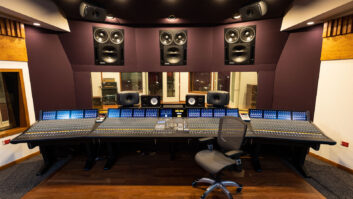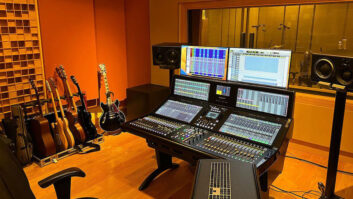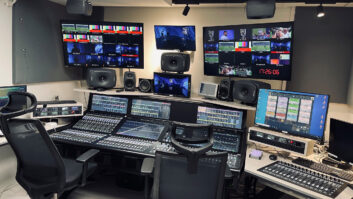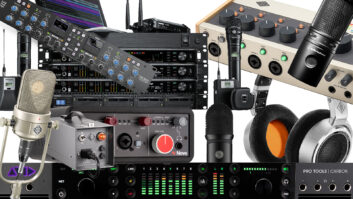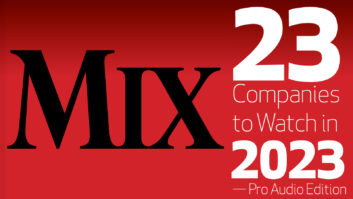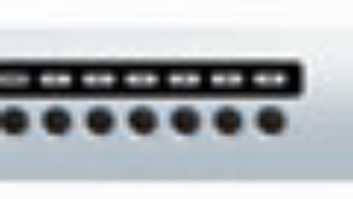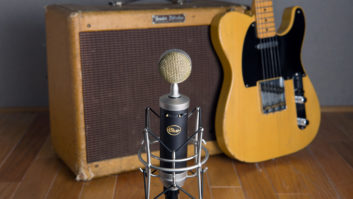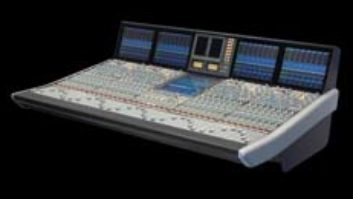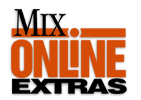
Mention the name Solid State Logic in audio circles and images oflarge, high-ticket, state-of-the-art consoles immediately come to mind.However, since the debut of SSL’s new C Series boards at last week’sAES convention in Amsterdam, the “large” and“high-ticket” terms are being removed from theequation.
Designed for fast-paced, on-air work and live-to-tape studioproduction, the new-generation C100 is a scalable, small-footprintdigital console that takes an innovative approach to assignability.
The C100’s key design elements included flexibility in the size ofthe control surface, as well as making the processor space as efficientas possible. “In certain applications, especially in broadcastwhere we’re looking at smaller rooms,” explains SSL’s NiallFeldman, “control surface assignability is essential, and digitalconsole users have been asking for a platform where they could specifythe number of physical channel faders, independent of varying theamount of processing to meet their channel countrequirements.”
With these criteria in mind, the C100 system comprises a virtualcontrol surface with a DSP rack that can be located some distance fromthe worksurface. The processing rack uses a mid-plane approach thatplugs the DSP cards from the front and the I/O cards on the back, so asingle 15-rackspace chassis has the capacity of up to 128 channels ofoperation. Channel capability can be expanded via 32-channel plug-inDSP cards, and the back plane can handle more than 500 inputs andoutputs.
The control surface itself can range from a compact — under ameter wide — version with 16 channel strips and a master sectionusing bank switching to control as many input channels as necessary.However, the controller’s physical size can be deceiving: “Withthe C100 control surface, you can assign control of multiple channelsto a single fader, so a 6-channel feed could be under the control of asingle fader,” says Feldman. “Using a couple of stereochannels, a couple of mono channels and some 5.1 channels, you couldhave the equivalent signal processing of a 40-fader console, each witha single fader controlling levels — all done using a 16-faderframe, although most users will probably opt for the flexibility ofhaving 24 channel strips. Alternatively, users can spec a console withone-fader-per-channel functionality.”
The console can be ordered with 32, 64, 96 or 128 fully featuredinput channels. A dedicated N-1 bus, two program buses, eight groups,24 utility and 24 aux buses are all standard, as are per-channeldirect/N-1 and utility outputs. The C100 has a 24-bit/48kHz design I/Oarchitecture, although with future formats in mind, the 40-bit,floating-point DSP core design is independent of sampling rate and canhandle up to 96kHz signals. Available I/O cards include MADI, AES/EBUand analog I/O, with onboard sample-rate conversion standard on alldigital input cards.
Going beyond the board’s redundant, dual power supplies, the C100incorporates innovative techniques, including a self-healing mechanism.The latter self-monitors all of the DSP in the processor; if a fault isrecognized, it automatically resets the specific segment of DSP withoutimpact to other mix processes occurring in the system. Rounding out thepackage are rapid reboot times, hot-swappable components and remotediagnostics.
Other broadcast-specific features include Control Linking, which canlink a range of configuration functions to a specific input or output,such as fader-start GPIs to cart machines. Audio-follow-video (AFV)functionality is standard, as are comprehensive GPI options to ease thephysical integration of the console into the existing studio controlinfrastructure.
One of the C100’s unique aspects is a Conceptual Central section,offering fast access to routing and dedicated output processing.“A main challenge in designing a broadcast console is handlingmultiple audio sources — not only inputs, but many outputs andfeeds going out,” Feldman says. “Traditionally,broadcasters deal with this by surrounding themselves with meters onall important studio outputs. For example, if you’re mixing a live 5.1sports program and have multiple output feeds going to multipledestinations, the question is how to control and monitor those feedsquickly, and know what’s going on on each bus output. Our solution wasa dedicated, central touchscreen control section allied withinteractive metering of console buses. The other key to fast ergonomicswas placing dedicated and assignable controls below that screenfor those tasks.”
In addition to the main touchscreen, high-res TFT screens above eachgroup of eight faders are used for channel metering and statusinformation. Below the screens, dedicated one-knob-per-function channelstrip controls (EQ, dynamics, etc.) can be assigned to any fader(s)within that section.
One innovative option is the C-SB Stagebox with up to 48remote-controlled mic preamp inputs in a single 14U chassis thatconnects to the C100 DSP core via up to 500 meters of fiber optics. TheStagebox also has some outputs to return foldback feeds, as well asGPIs to control on-air lights on the stage, etc.
The first C100s are already in delivery, and pricing is said tostart “well below” $200,000. But perhaps the bignews is that at press time — just days before the C100’s AESlaunch — we heard that SSL was also going to unveil the C200, acompact music production board based on a similar processingarchitecture. Details are sketchy at this point; we’ll provide more onthis development next month.
For more information, visit www.ssl-broadcast.com.

SSL C100-detailed audio subgroups page

SSL C100-processor routing

